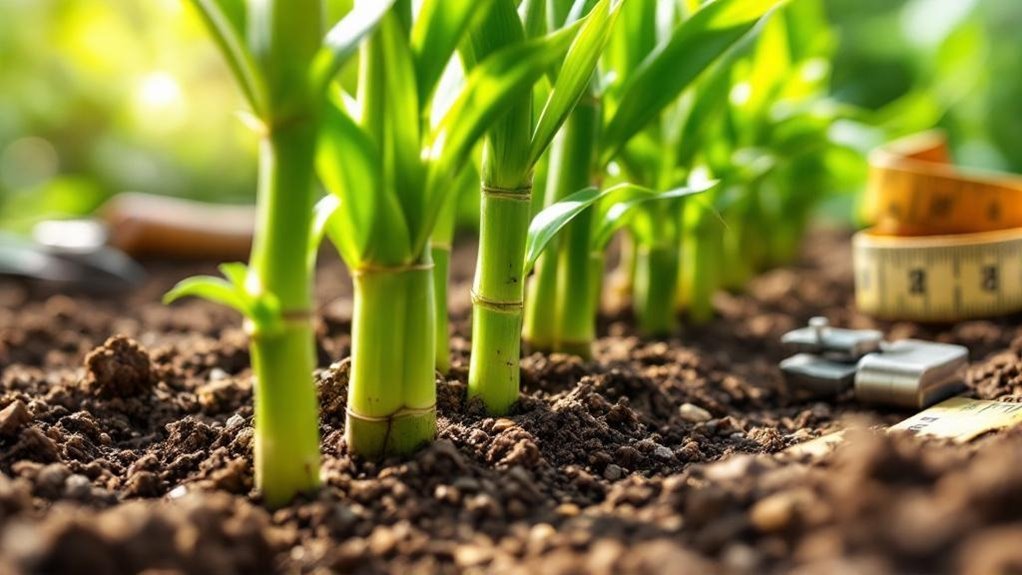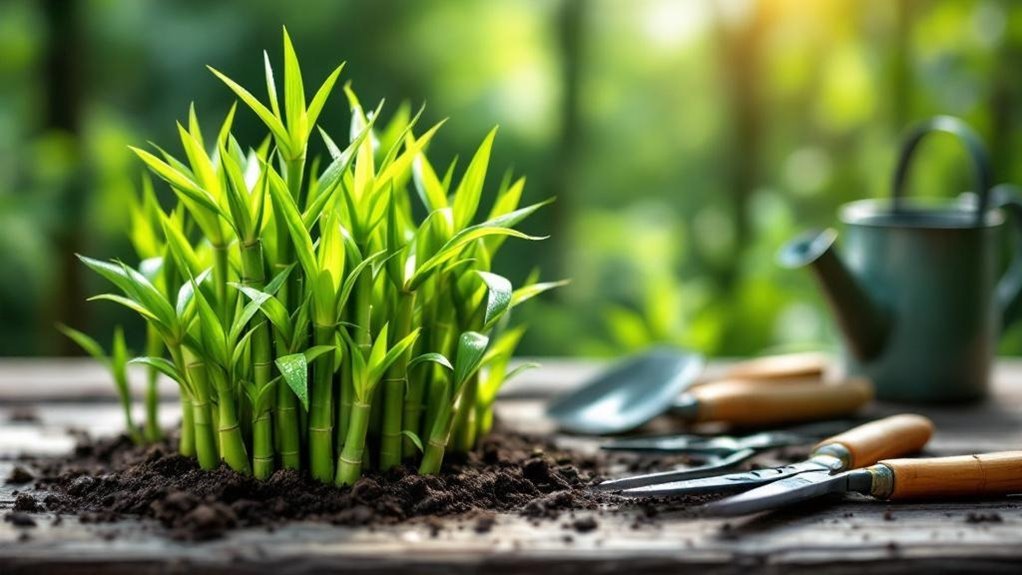It’s interesting how just as you’re considering adding bamboo to your garden, you might also be thinking about how quickly it can spread if not managed properly. You’ll want to balance its fast growth with effective control to keep it from overtaking your space. Fortunately, there are practical steps you can take from the start to guarantee your bamboo thrives without becoming a problem. Let’s explore what those steps involve.
Placement and Spacing Strategies for Optimal Growth
Where should you place your bamboo to guarantee it thrives?
Start by considering sunlight: large bamboo varieties need over 5 hours of sunlight daily, while clumping types prefer light to moderate shade.
Large bamboo thrives with over 5 hours of sun, while clumping types favor light to moderate shade.
When planting, dig holes 1.5 to 2 times wider than the bamboo root mass and backfill with a mix of compost and local soil to guarantee ideal nutrient supply.
For dense screens, space bamboo rhizomes 3-5 feet apart to balance growth and coverage. If you want quicker coverage, plant closer; otherwise, allow 5-20 feet for slower growth.
After planting, water thoroughly and add a 2-3 inch compost layer to retain moisture.
Thoughtful placement and spacing give you better control over bamboo’s spread and promote healthy, vigorous growth.
Containment and Control Methods for Running Bamboo
After carefully choosing the right spot and spacing for your bamboo, you’ll want to keep its growth in check, especially with running varieties that can spread aggressively.
Installing a physical barrier, like a 30-40 mil thick rhizome barrier buried 22-30 inches deep, guarantees containment by blocking underground rhizomes. Make sure to overlap ends by at least 30 cm and extend the barrier 7.5 cm above soil to stop escape.
Regularly cutting unwanted shoots during the active growth period helps manage new growth, preventing spread. For stubborn patches, digging out root systems offers effective eradication, though it’s labor-intensive.
Chemical control with glyphosate can also help but requires careful, repeated applications. Combining these methods gives you solid control over running bamboo’s invasive tendencies.
Planting Techniques and Soil Preparation

Although bamboo is a hardy plant, proper soil preparation and planting techniques are crucial for its healthy growth.
When planting bamboo, dig holes 1.5 to 2 times wider than the root system, mixing local soil with compost to improve nutrient availability. Bamboo thrives best in moderately acidic, loamy soil; if your soil is heavy, add organic amendments to enhance drainage and root development.
Dig wide holes and enrich heavy soil with compost for healthy bamboo root growth.
Space bamboo plants 3-5 feet apart to allow for ideal growth and screening, adjusting spacing for faster spreading types.
After planting, apply a 2-3 inch layer of compost on top to aid moisture retention and promote healthy root development.
Finally, water bamboo thoroughly, ensuring the soil surface dries before watering again to encourage strong establishment without risking dehydration.
Watering, Fertilizing, and Maintenance Practices
Proper watering and fertilizing play a key role in helping your bamboo establish strong roots and thrive after planting.
Water your bamboo regularly, allowing the soil surface to dry before watering again—typically 2-3 times a week in summer with 1-2 gallons per session guarantees peak growth.
Fertilize three times during the growing season using a high nitrogen fertilizer (20-5-10) or an organic bamboo fertilizer (8-2-2), following package instructions.
Apply a 2-3 inch layer of compost to retain moisture and boost nutrients.
Monitor young plants closely for dehydration signs like curling leaves and adjust watering accordingly.
For maintenance, mulch around bamboo to retain moisture and suppress weeds, and regularly check root health, especially with running bamboo, to support vigorous, healthy growth.
Propagation and Care for Healthy Bamboo Development

How can you successfully propagate bamboo to guarantee healthy growth?
Start by dividing younger rhizomes from the outside of the clumping bamboo in mid-spring, focusing on new canes for vigorous establishment.
Alternatively, take rhizome cuttings from young canes at the clump’s edge in early spring, placing them in gritty compost to encourage rooting.
If you’re propagating by seed, sow viable seeds immediately after flowering using a mix of multi-purpose compost and perlite for proper drainage.
Throughout the growth period, maintain consistent watering to keep the compost moist, especially for container plants, preventing shriveled foliage.
For effective bamboo control and healthy growth, thin dense clumps in spring to improve air penetration and light access, fostering stronger health and reducing overcrowding.
Frequently Asked Questions
What Is the Best Way to Control Bamboo?
To control bamboo effectively, you should install a deep rhizome barrier, regularly cut new shoots in spring, and consider digging out roots. You can also use undiluted glyphosate on cut culms for chemical control.
What Is the Downside of Bamboo Plants?
You’ll find bamboo can become invasive, requiring lots of water and nutrients. It might crowd other plants, and controlling its spread takes effort and barriers. Plus, container-grown bamboo can suffer in cold weather.
Do Coffee Grounds Help Bamboo Grow?
Yes, coffee grounds can help your bamboo grow by enriching soil with nitrogen, improving moisture retention, and providing a slightly acidic environment. Just use them sparingly to avoid nutrient imbalances or caffeine-related growth issues.
Is It Legal to Grow Bamboo in the US?
You might find bamboo’s freedom a bit restricted, depending where you live. Some states ask you to keep it in check or choose less adventurous varieties. Always check local rules before planting to stay on the safe side.
Final Thoughts
By placing your bamboo thoughtfully, controlling its spread carefully, and preparing the soil properly, you set the stage for success. By watering consistently, fertilizing regularly, and mulching generously, you nurture healthy growth. By managing shoots diligently, installing barriers effectively, and spacing plants wisely, you prevent unwanted invasion. Follow these steps, and you’ll enjoy a vibrant bamboo landscape that thrives beautifully while staying perfectly contained.
